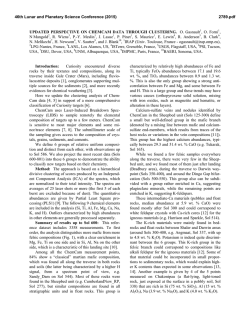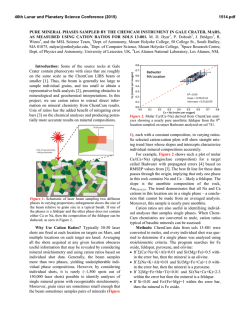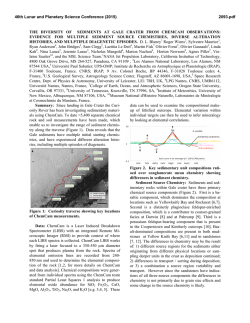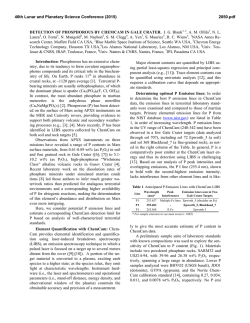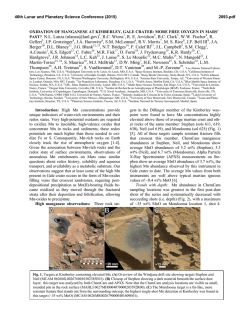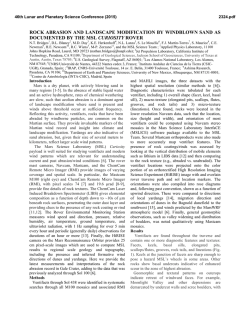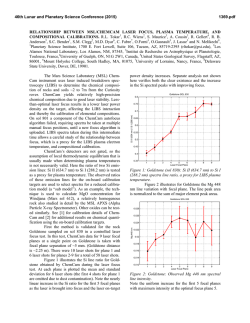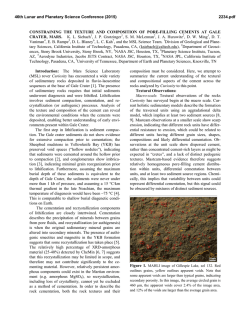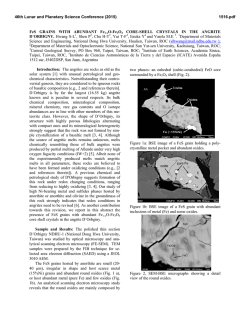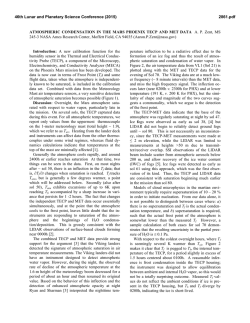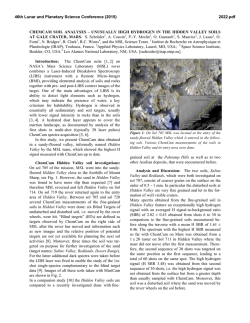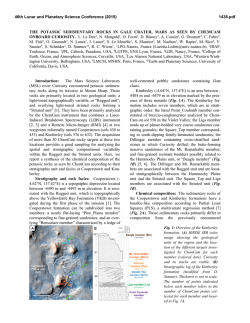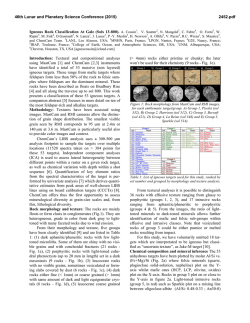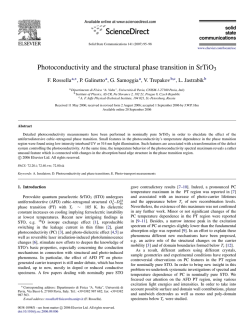
centimeter to decimeter size spherical and cylindrical features in
46th Lunar and Planetary Science Conference (2015) 1249.pdf CENTIMETER TO DECIMETER SIZE SPHERICAL AND CYLINDRICAL FEATURES IN GALE CRATER SEDIMENTS R.C. Wiens1, S. Maurice2, O. Gasnault2, S. Clegg1, C. Fabre3, M. Nachon4, D. Rubin5, W. Goetz6, N. Mangold4, S. Schröder2, W. Rapin2, R. Milliken7, A.G. Fairén8, D. Oehler9, O. Forni2, V. Sautter10, D. Blaney11, S. Le Mouelic4, R.B. Anderson12, A. Cousin2, A. Vasavada11, J. Grotzinger13, and the MSL Science Team (1LANL; [email protected], 2 IRAP/CNRS, Georessources3, LPGN4, 5UCSC, 6MPS, 7Brown, 8CAB, 9Jacobs LZ, 10MNHN, 11JPL/Caltech, 12 USGS Flagstaff, 13Caltech) Overview: The Curiosity rover traverse in Gale crater has explored a large series of sedimentary deposits in an ancient lake on Mars. Over the nine kilometers of traverse a recurrent observation has been southward-dipping sedimentary strata, from Shaler at the edge of Yellowknife Bay to the striated units near the Kimberley [1]. Within the sedimentary strata cm- to decimeter-size hollow spheroidal objects and some apparent cylindrical objects have been observed. These features have not been seen by previous landed missions. The first of these were observed on sol 122 in the Gillespie Lake member at Yellowknife Bay (Fig. 1). Additional hollow features were observed in the Point Lake outcrop in the same area. More recently a spherical and apparently hollow object, Winnipesaukee, was observed by ChemCam and Mastcam on sol 653. Here we describe the settings, morphology, and associated compositions, and we discuss possible origins of these objects. Fig. 1. Hollow spherical feature observed on sol 122 in the Yellowknife Bay area. The visible portion is 16 cm in diameter. Settings and Morphologies: The first several such features were observed in the Gillespie Lake member [2], one named Tochatwi (Fig. 1) and one near the ChemCam target Kahochella (sol 124; not shown). On a Navcam mosaic several of these objects can be seen in a line at regular 1-2 m intervals. They appear darker than the surrounding material and are hollow. No such features were observed across Bradbury Rise, which is covered with alluvial material. Winnipesaukee: Another feature (Fig. 2) was observed by ChemCam and Mastcam south of the Kimberley and before reaching Hidden Valley. Winnipesaukee is hollow, spherical, and clearly darker than the surrounding sediments, similar to the sol 122 objects. The overall dimension is approximately 38 mm across. The walls are ~2-3 mm thick. The outer surface is irregular and is flecked with lighter-toned grains. The host rock is light-toned and appears to contain some darker clasts, some of which appear angular. The darkertoned pebbles nearby may be related to these darker clasts, potentially having weathered out of the rock. Of the 1x10 LIBS raster the 1st, 9th, and 10th points (right to left, Fig. 2) appear to have hit host nd rock, the 2 point may have hit a pebble, and the 4th and 5th points interrogate soil inside of the feature. Investigation of shot-to-shot trends shows that all 30 shots of point 5 interrogate soil, but only the first few shots of point 4 are in soil and the last few shots apparently sample the interior of the feature. The 6th-8th points clearly hit the outside of the spheroid. Compositions determined by ChemCam LIBS using PLS1 [3] (Table 1) confirm that the host rock is high in Si, Al, and alkalis, consistent with its light tone. The compositions of points 6-8 (Fig. 2, rt to left, red circles) on the exterior of the feature itself are high in FeOT (13-18 wt%) and have moderate SiO2 (48-52 wt%), however the compositions of Ca, Mg, Al, Ti, and K are variable, with up to 3.2 wt% K2O in point #6 and up to 14 wt% CaO in point #8. The last ten shots of point 4, which likely sampled the interior of the spheroid, are richer in Na2O and display a strong H peak, and are slightly poorer in FeOT than the range observed on the exterior sampled by points 6-8. The points sampling the exterior all display hydration, but at a lower level than the interior surface. It is not clear if the increased H in the interior surface is due to being covered by hydrated soil or whether this hydration is inherent in the material. On the other hand, the sodium enrichment on the interior surface is clear; there is no obvious association of this Na with enrichments of other elements, but given the relatively low sensitivity of ChemCam to chlorine, an association with Cl could not be ruled out. Discussion: Winnipesaukee is hollow and Caand iron-rich, unlike the composition of the host rock. It is not clear if these objects are a Mars equivalent of geodes, in which an iron-rich fluid precipitates into a void left by a bubble of gas or volatile-rich material. Winnipesaukee appears to contain light-toned flecks; given the variability of Ca in observation points 6-8, these could contain Ca enrichments. The difference in composition between the rounded feature and the host rock rules out any possibility that these features are 46th Lunar and Planetary Science Conference (2015) part of gas-enriched lava flows, in which case the composition of the host rock and the rounded feature would be similar. Other Hollow Rounded Features: A number of hollow features were also observed weathering out of the Point Lake outcrop in Yellowknife Bay, near the sol 122 feature (Fig. 1). However, a number of these were more irregular in shape with walls of variable thicknesses, often blending into the surrounding rock; some contained erosion-resistant features in the interiors. Pillow lavas were suggested as a possible origin of these features, but overall the outcrop displays characteristics that are more consistent with a sedimentary origin [2]. Within the latter context these features are also suggested to originate as gas bubbles within sediments. Larger and thicker-walled features have also been seen. The largest of these was the Tappers “fire ring” (Fig. 3) near the middle of the Moonlight Valley at its head just above Dingo Gap Dune. This object is ~0.6 m in diameter. The walls extend upwards ~7 cm above the center and were several cm thick. The walls are fractured vertically, giving the overall appearance of rocks 1249.pdf being fitted together to form a ring. Texture at a sub-millimeter scale is somewhat ventifacted and unevenly weathered. A number of ~1 mm spherical grains appear to be weathering out of the mass (Fig. 3c) but individual grains are otherwise not clearly visible. Several other features possibly related to Tappers were observed farther down the valley; they are similar in appearance but smaller in size. As the overall texture and compositions of these features are clearly different from the smaller spherical objects, we suggest that they had a different origin. In sedimentary regions containing evaporates, pipes of downward sedimentary flow occur after dissolution of the evaporate layer, as it is filled with material from overlying layers [4]. Acknowledgements: This work was supported by NASA’s Mars Exploration Program in the US and by CNES in France. References: [1] Stack K.M. et al., this meeting. [3] Wiens R.C. et al (2013) SCAB 82, 1-27. [2] Grotzinger J.P. et al. (2013) Science, DOI:10.1126/science.1242777. [4] Hunter R.E. et al. (1992) USGS Bull. 1808-L. Fig. 2. Winnipesaukee hollow spherical feature shown at increasing resolution left to rt. (a) Right Mastcam, sol 654; (b) Color merge of RMI with left Mastcam, sol 654. Circles indicate the locations of ChemCam LIBS observations; colors indicate compositional detail. Red = basaltic; black = felsic; green = soil. Sequence starts from right. (c) RMI mosaic taken after the laser shots, locations indicated. Fig. 3. Circular rock feature Tappers (~0.6 m diameter), shown at increasing resolution from left to rt. (a) Right Navcam sol 527. (b) Right Mastcam, sol 528; (c) RMI, sol 530, laser locations indicated. Approximate position of (c) is indicated in yellow in (b).
© Copyright 2025
